
David Goodis had been working as a screenwriter in Hollywood for just three years when in December 1945 he seemed to get his big break. He sold his story Dark Passage to Warner Brothers for $25,000. The next year The Saturday Evening Post serialized it and Julian Messner published it as a book. The 1947 movie, written and directed by Delmer Daves and reuniting Humphrey Bogart and Lauren Bacall for the third time, proved a hit. But not only would sustained success elude Goodis, the fall from it would become one of his most compelling themes. Even the opening lines of Dark Passage hint at his dark view of the world:
It was a tough break. Parry was innocent. On top of that he was a decent sort of guy who never bothered people and wanted to lead a quiet life. But there was too much on the other side and on his side of it there was practically nothing. The jury decided he was guilty. The judge handed him a life sentence and he was taken to San Quentin.
Goodis’s short-lived marriage fell apart, few of his screenplays were produced, and by 1950 he was back living with his parents in Philadelphia. Yet it was in that quiet urban setting that over the next seven years he wrote the ten novels, all of them paperback originals, that defined his style. Geoffrey O’Brien describes that style in Hardboiled America: Lurid Paperbacks and the Masters of Noir:
Anyone who spends some time with [Goodis’s] books learns to identify their peculiarly intense atmosphere, their outbursts of eloquence, their sense of the world as an abyss made for falling into. His best books have a unique poetry of solitude and fear. They read like the improvisations of someone compelled to keep writing, to keep the words, the pages coming toward him. He writes knowing he must fill the page, finish the episode, continue as far as the next episode, the next book. His central image is ultimately that of the wounded man, his strength gone, pulling himself forward, yet sensing that he won’t make it, that it will all have been in vain.
O’Brien singles out The Burglar (1953) as exemplary:
The Burglar (1953) stands out for its evocation of a Romantic death-wish in the context of a disposable drama of low-grade crooks coming unraveled in the wake of a bungled break-in, an evocation which culminates memorably in an offshore Liebestod in Atlantic City. The Burglar’s prose style is notable as well: Goodis seems really to have worked on this one, piling on little flourishes of syncopation that remind us how musical his ear could be. If Jack Kerouac had written crime novels they might have sounded a bit like this, as bop prosody modulates the stark lines of pulp narration.
Reviewing David Goodis: Five Noir Novels of the 1940s & 50s in The Wall Street Journal, Lee Sandlin was also struck by the “neurotic intensity” of the hero of The Burglar:
Toward the end of the novel, he and his beloved are on the boardwalk in Atlantic City, and the sight of the passersby prompts him to offer this tender aria: “Look at them walking. When they take a walk, they take a walk, and that’s all. But you and I, when we take a walk it’s like crawling through a pitch black tunnel.”As you might imagine, things don’t end well for this couple. But the most striking thing about Goodis is that you feel worse when everything does work out.
Volume editor Robert Polito, in his introduction to a previous edition of Street of No Return, calls Goodis “our most crafty and elegant crime stylist.”
Noir is characteristically a language of objects, places, and names, an idiom that in a few bluff words summons worlds. . . . For Street of No Return Goodis devised a snaky diction, at once fantastic and matter-of-fact. Here objects tend to speak. A bottle, a blackjack, a window, a train, even Hellhole itself. “No sirree, the Hellhole said to Captain Kinnard of the Thirty-seventh District, this is our boy Whitey and we won’t letcha have him…It wasn’t anyone’s voice and yet Whitey could almost hear it talking. He began to have the feeling a lot was going to happen before morning.”
Over the years since they were first published, many of Goodis’s novels have become hard-to-find collector’s items. With the publication of this LOA volume, American readers can now discover what cult fans of David Goodis have been raving about for quite some time.



